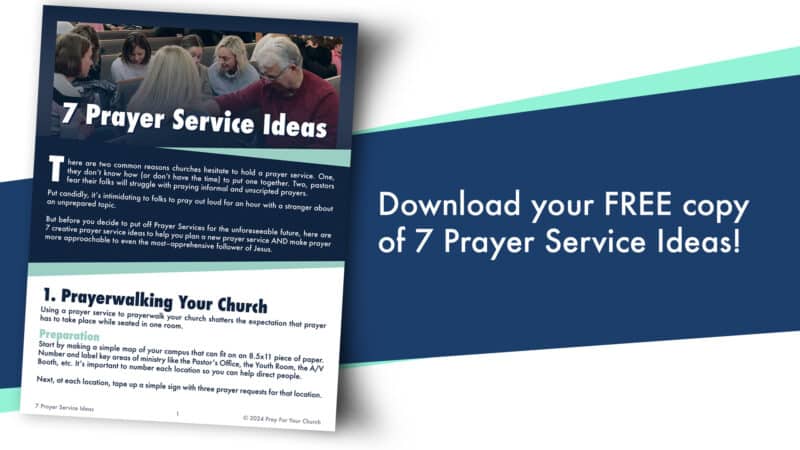
Here are five of them:
1) Start with private prayer services before going public.
If I could go back in time, I would’ve started with invite-only prayer services. Start small. Grab three prayer warriors of the church and get together to pray.
I would then run these small prayer gatherings like an informal prayer service. I’d use Scripture and music to get started, and then leave space for conversational prayer. I prefer something like 30 – 45 minutes here. Yes, you could pray for more and pray longer, but there is plenty of time for all of that later. The point here is to just get started. To borrow from Jim Collins in Good to Great, you’re just trying to get the Flywheel moving.
One of the benefits of “soft-launching” prayer services is it takes away your anxiety of failure. This isn’t a program failing or succeeding, you’re just getting together with friends to pray.
But you’re not done yet.
After you feel like these private prayer meetings are established, talk to each of them about your hopes to start a church-wide prayer service and ask them to invite their own three people for another informal prayer service. Then, gather with that group of 12-15, and hold another informal prayer service or three. It’s a bit more formal than 4 people huddled around a table, but it’s still just Scripture, music, and a time for conversational prayer.
Soon, you’ll have the buzz and base you need to launch an official prayer service. Who knows, some of these folks in your soft-launch might take on leadership or planning roles.
2) Choose a sustainable schedule for your prayer services.
What’s true for music is true for programming–it’s easier to speed up than slow down. You can start a weekly prayer service, but realize that after this week is next week. And after next week is the next week. With all of its planning and logistics and equipment and volunteers and… it can be hard to develop something because you’re working so hard to sustain it.
Alternatively, when you start a prayer service in a more realistic frequency like once-a-month, it’s far less stressful to sustain. And, you’ll have time to develop it for growth. After you get some momentum and find out what your baseline is, then decide when and if you’ll increase the frequency.
Whatever frequency you decide on for prayer services, remember it’s a marathon, not a sprint. As Dallas Willard once defined discipleship, this is a “long obedience in the same direction.”
3) Limit your prayer service to your church.
This is just my opinion, and the Lord may be leading you otherwise, but I suggest keeping your new prayer service focused on your church.
I understand the sentiment of opening up a prayer service to other churches in the area, but for the time being, I say stay small. This is about your people praying for your people and your church. As the prayer service grows, you may branch out for a greater city–wide effort, but doing so too soon can diminish the sense of responsibility and ownership your own congregation feels for your new prayer service.
Asked another way, would you be satisfied if another church or people from another church took on leadership for your prayer service? It may not start there, but it could lead there with a true egalitarian, cross–denominational approach to a prayer service.
4) Design your prayer service to be a place to develop new leaders.
Don’t let your prayer service be another burden on your already over-burdened volunteers. Making bricks without straw (Exodus 5:6-9) is not an enjoyable undertaking. Instead, design your prayer service to be a place to develop new leaders.
It’s hard to “equip the saints for the work of the ministry” (Ephesians 4:12) when Sunday mornings are so demanding. An audience of a few hundred people is not an ideal place for a piano player to learn how to lead worship. Or for an audio engineer to learn mixing. Or that new elder to try public speaking.
This is where a prayer service becomes a valuable place to develop new talent for the church. A farm team, if you will. Suddenly, your volunteers can learn their craft without the added pressure of doing so in front of dozens of strangers. Prayer services, by nature, will be the committed folks of your congregation who are more familiar and, typically, more gracious towards any mistakes a new volunteer may make.
5) Invite people organically.
Finally, when it comes to advertising your prayer service, make your invitations as organic as possible. Yes, you can still make announcements on Sunday morning and send email blasts, but prayer services need a different communication.
People are inherently intimidated at the idea of praying aloud with others, and people underestimate the importance of it, so the communication needs to be personal.
Think through a communication plant that involves hand-written notes inviting key leaders to your prayer service. Ask your elders to each invite one lay person. Ask your men’s Bible Study for a few minutes of their time to talk about the need for prayer.
Casting a vision for a prayer service requires both fine–motor and gross–motor skills.
Hopefully, this short list gave you a few things to think about and plan before you think about and plan your actual prayer service. I know you’re eager to get going, but slowing down to implement these ideas will help you in the long run. Not only will your prayer service be healthier and better attended, but more people will pray more prayers.
And isn’t that why you’re doing this in the first place?


